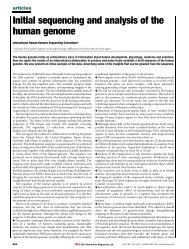Predictors of Foreign-Language Anxiety: Examining the ...
Predictors of Foreign-Language Anxiety: Examining the ...
Predictors of Foreign-Language Anxiety: Examining the ...
Create successful ePaper yourself
Turn your PDF publications into a flip-book with our unique Google optimized e-Paper software.
Data analysisTo investigate how <strong>the</strong> selected learner variables (pr<strong>of</strong>iciency, FL aptitude,strength <strong>of</strong> motivation, L2-self-concept, perfectionism, and competitiveness) arerelated to FLA, and what contribution <strong>the</strong>y make to its prediction, two procedureswere used. Pearson correlations were computed to assess <strong>the</strong> strength and direction<strong>of</strong> <strong>the</strong> relationship between anxiety and each <strong>of</strong> <strong>the</strong> six learner characteristics. Multipleregression analysis was used to assess <strong>the</strong> effect <strong>of</strong> <strong>the</strong> six learner variables simultaneouslyand determine <strong>the</strong>ir relative contribution to <strong>the</strong> prediction <strong>of</strong> FLA.Standard Multiple Regression was run first, with all six predictor variables enteredinto <strong>the</strong> regression model. This procedure was used so as to assess (1) towhat extent this set <strong>of</strong> individual learner variables is useful in explaining differencesin participants’ anxiety level, and (2) what each independent variable addsto <strong>the</strong> prediction <strong>of</strong> FLA that is different from <strong>the</strong> contribution <strong>of</strong> <strong>the</strong> o<strong>the</strong>r predictors.Total variance explained (R 2 ) was used as a measure <strong>of</strong> <strong>the</strong> predictive power<strong>of</strong> <strong>the</strong> six independent variables, while squared partial correlation coefficients asan estimate <strong>of</strong> <strong>the</strong>ir unique contribution as a proportion <strong>of</strong> R 2 . To determinewhe<strong>the</strong>r <strong>the</strong> obtained values were indicative <strong>of</strong> a small, medium, or large effect,Cohen’s (1988) criteria were used, according to which, values between 2% and12.99% suggest small, values 13% - 25.99% medium, and values <strong>of</strong> 26% or abovelarge effect sizes for multiple regression models in <strong>the</strong> behavioural sciences. Finally,a backward selection method was adopted to identify <strong>the</strong> best predictors <strong>of</strong>FLA. To assess <strong>the</strong> relative importance <strong>of</strong> <strong>the</strong> best predictors <strong>of</strong> participants’ anxietylevel standardized correlation coefficient (β) and squared partial correlationvalues were examined.ResultsCorrelation findingsTable 1 presents <strong>the</strong> correlations between each <strong>of</strong> <strong>the</strong> selected learner variables -cognitive, affective, and personality-related ones – and foreign language anxiety.Of <strong>the</strong> six examined variables four were significantly related to FLA, namely, pr<strong>of</strong>iciency,L2-self-concept, perfectionism, and competitiveness.Tóth, Zs. <strong>Predictors</strong> <strong>of</strong> foreign-language anxiety 133
















